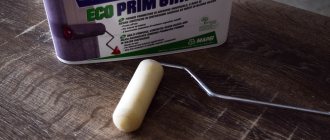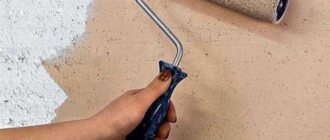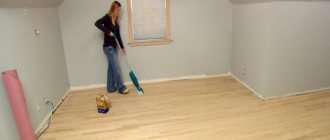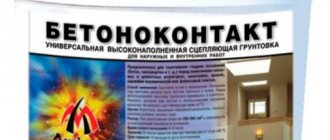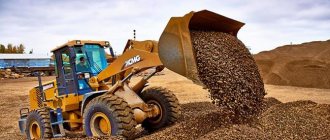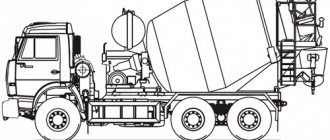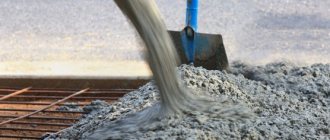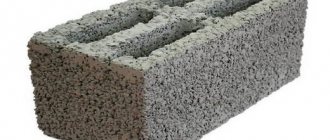Quite often during the renovation process it is necessary to combine some materials. But due to their properties, they adhere very poorly to the surface. For example, it is quite difficult to attach tiles to metal or wood. In this case, it is necessary to use concrete contact primer. In this article we will talk about the technical characteristics of this solution and its consumption per 1 m2 of wall, and also consider the advantages of the Knauf primer.
Where can it be applied?
So, the main property of concrete contact is to increase the adhesion rate of a surface with poor moisture absorption. So, concrete tends to repel moisture, and therefore any finish does not adhere well to it. In this case, you can use concrete contact primer and, due to its properties, increase the adhesion rate.
Previously, professionals used a special fastening for this purpose, which was called a bandage. This made it possible to safely plaster concrete walls. But now, with the advent of concrete contact, the need to install such a heavy fastening has disappeared. After all, the effect of the solution is much stronger, and the method of application is much simpler.
This material can be used for both internal and external treatment of premises. Thus, concrete contact primer is used to finish a building before treating it with façade plaster, which allows the coating to adhere perfectly. This primer can handle almost any wall, which is also a definite advantage. It can be used for finishing wood, metal and other coatings. Using this mixture, you can be sure that any coating will last on the wall for a long time.
Where is it used?
Betokontakt is recommended for preparing bases of various chemical natures. They can be smooth, poorly absorb water or not even be wetted by it - monolithic concrete blocks, polystyrene foam. And also enter into a chemical reaction with finishing coatings. For example, plaster based on lime and gypsum can destroy a sand-cement mixture or plasterboard that has hardened and gained strength. A mixture of acrylic binder and sand isolates them from each other and ensures a reliable connection of substances that are incompatible under normal conditions.
However, the scope of application of the Betokontakt Knauf primer is much wider; it is limited only by the degree of sophistication of the mind of the builder-finisher into whose hands it fell. Here are some examples of its non-standard use:
- It will help to securely fix decorative stucco molding on any smooth surfaces.
- Allows you to lay new tiles without dismantling the old ones.
- You do not need to peel off layers of oil or alkyd paint - apply Betokontakt primer directly onto them and get a reliable base for the final plaster layer.
- When decorating loft-style rooms, it can be used to prime metal or reinforced concrete structures with embedded elements.
- Dust removal of surfaces.
Specifications
Concrete contact has the property of turning a smooth wall into a rough one and is classified as a primer material. Due to the presence of quartz sand in its composition, concrete contact is capable of connecting almost any materials. Technical characteristics include:
- relatively high drying speed of the material. You can continue repairs within two hours after applying the solution;
- excellent moisture resistance. The concrete contact primer can be considered a waterproofing finish, because after drying a waterproof film is formed on the surface;
- Due to protection from external damage, it can serve you for many years, which is a plus. The average lifespan is approximately sixty years.
Concrete contact - characteristics of different brands of primer
The components of concrete contact are Portland cement, sand, acrylic. The material can be used once after shaking.
It is recommended to use it to:
- prevent paint deterioration on dry plaster;
- make plastering easier;
- improve the adhesion of tiles to concrete walls;
- close seams and cracks;
- reduce premature shedding of finishing materials.
Knauf brand primer contains acrylic, which gives it increased resistance to moisture. At the same time, the quality of surface preparation is no worse than that of most other auxiliary materials (and sometimes better):
| Options | Meaning |
| pH level | 7,5 |
| Primer color | Pink or orange |
| Heat resistance of dry surface | -200С/+800С |
| Consumption, kg/m2 | 0,35 |
| Tara | Plastic bucket 20 liters |
| Shelf life | 1 year |
| Store in a dry place at a temperature | ≤ +10С |
Ceresit ST 19 concrete contact primer:
| Options | Meaning |
| Surface type | Concrete |
| Drying time | 180 minutes |
| Limit temperatures | +350С/+50С |
| Purpose | Indoors |
| Tara | Bucket 5 liters |
| Shelf life | 12 months |
| Application technology | Brush or roller |
Ceresit primer
VD-AK-014 concrete contact primer:
| Options | Meaning |
| Density, g/cm3 | 1,37 |
| Consumption, g/m2 | 130-160 |
| pH | 7,5-9,0 |
| Drying time | 60 minutes |
| Limit temperatures | +350С/+50С |
| Frost resistance 5 cycles feast temperature | -400С |
| Application | brush, roller |
Universal primer Betokontakt brand VD-AK-014
- Quick drying: after 2-2.5 hours you can continue working with the surface;
- The high coefficient of moisture resistance allows the composition to be applied under a concrete screed;
- The service life of the substance is 80 years or more;
- Shades of different colors help visually determine the uniformity of the layer applied to the walls.
Both the composition and characteristics of the primer fit the definition of a universal mortar, since the instructions for use show that even an untrained person can work with the liquid.
Primer consumption concrete contact
Consumption directly depends on the type of surface. If the wall absorbs moisture well, then the consumption per 1 m2 will increase significantly. Concrete contact can be used for finishing brick, tiles, drywall and other coatings. To roughly calculate the mixture consumption, you will need to divide the surfaces into three groups: highly porous, with average porosity and without pores.
So brick and concrete belong to the porous group. The primer consumption for such a wall is on average 0.4 kg per 1m2. For finishing with an average porosity, which includes building tiles or monolithic concrete, an average of 0.2 kg of solution per 1 m2 will be required. Finally, non-porous surfaces will require the least mixture. The consumption will be approximately 0.15 kg for 1m2. As you can see, you don’t need a lot of mixture, so it’s quite an economical option.
Thanks to these characteristics, concrete contact has gained wide popularity among both professionals and beginners in the construction business. To learn more about this solution, let's look at a specific brand, Knauf primer.
Application process
The finished product is already ready for application; you do not need to dilute it with water, since the manufacturer prepares the primer in the desired consistency. Before applying the primer, gently clean the surface thoroughly. To do this, be sure to remove any existing dirt, dust and remnants of previous material.
What is the consumption of deep penetration primer + per 1 m2 can be found out by reading the article.
All activities should be carried out at temperatures of +30 degrees. If there are peeling areas on the base, they need to be removed and the damage repaired. You cannot treat the surface using a roller, brush or brush. The drying time for the primer solution will be 12 hours.
The video shows the application of the material:
Ceresit primer st 17 technical characteristics, consumption and other technical data are indicated in the article.
The primer is applied in two layers. But the second can only be processed if the first has been completely dried. When processing the surface, make sure that there is no dirt on the base, otherwise it will be impossible to achieve adhesion. The operation process can be carried out at temperatures of -40 – +60 degrees. Frost resistance can reach 5 cycles of freezing and thawing.
To achieve maximum results, it is necessary to use Betonokontakt primer in combination with a deep penetration primer. In this case, the first layer is a connection of materials, and the second is only Concrete Contact.
You can find out how long the primer should dry before applying putty from this article.
To apply the primer, you can use a brush, brush or spray. Which option you choose depends only on what type of surface is being processed. The consistency of the finished solution resembles water-soluble paint, making the application process easier.
Primer Knauf
The main components in production are acrylic and quartz sand. It is due to them that the adhesion improves and the wall becomes perfectly smooth. The main purpose of Knauf brand concrete contact will be to increase the level of adhesion of walls or ceilings for further processing with decorative coatings.
Knauf mixtures are sold in 20 kg buckets. The temperature for processing should be between five and thirty degrees. The average consumption of Knauf primer is about 0.3 kg for finishing 1 m2. The company has been producing building materials for a long time, so you don’t have to worry about the quality of the mixture. The solution is environmentally friendly, so it will not cause any harm to either humans or pets. Before use, we recommend that you read the manufacturer's recommendations on the packaging.
KNAUF-Betokontakt
I agree with the company’s use of my personal data to process this request. I have read the personal data processing policy. Submit Clear form. New on the site. Metal fittings More details. Steel flange More details. For example, a layer of plaster or putty applied to an untreated surface does not adhere.
Concrete contact Knauf, a primer from a well-known German manufacturer, will help cope with this problem. Thanks to its unique composition, the solution significantly improves the adhesive properties of the base, and any finishing material adheres well.
Composition and properties of the primer
The development is a special plaster primer with an acrylic base and high adhesion. Special binder fillers make Knauf concrete contact a universal composition that increases the adhesion of building materials and ensures long-term operation of the coating. One of the key properties of the primer is to retain the moisture of the leveling mixture, which guarantees uniform drying, and this, in turn, protects the walls from cracks.
In addition, when using Knauf concrete contact, the consumption of liquid finishing materials is significantly reduced. After applying the primer, air exchange between the living room and the street is normalized, plus the vapor permeability of wall coverings increases. An important property for which the primer deserves special praise is its ability to prevent the development of fungus and mold on the treated surface. Knauf primer is available in two types: one modification contains mineral particles measuring 0.3 mm, and the other - 0.6 mm.
The first is used for delicate work and before puttying, and the second is more suitable for rough finishing.
Application instructions
The method of finishing a wall with Knauf concrete contact is quite simple and does not require any special skills. The first step is to remove dirt, dust and old coating from the surface. We recommend that before applying the mixture, treat the surface with an ordinary primer to ensure that you get rid of dust and ensure the connection of the surface layer with the main solution. Before applying the primer, it is better to let the wall dry; it is highly not recommended to apply the substance to a damp coating.
Next, you need to apply the mixture to the wall. To do this, you can take a roller, brush or spatula. It is necessary to apply a thin layer and try to distribute it evenly over the entire plane of the wall.
After applying the primer, you need to give it time to dry. We recommend not to delay subsequent processing, since over time the level of adhesion decreases due to dust that forms on the wall. If a couple of days have passed after treatment with Knauf concrete contact, it is better to apply a regular primer to the wall to remove dust and dirt.
As you can see, the method of application is quite simple and does not require any special skills. The main thing is to use high-quality tools and materials.
Knauf Betokontakt primer consumption per 1 m2
Betokontakt from the Knauf company is a building material unique in its properties. The peculiarity of the primer is that it can be applied as a separator to different layers, thereby ensuring their strong adhesion to each other. Betokontakt primer fits perfectly on tiles, paint and other smooth surfaces, increases adhesion, which makes it possible not to dismantle the old coating, but to carry out puttying and subsequent finishing on top of it.
Peculiarities
Betokontakt primer is an acrylic dispersed mixture that provides high adhesion to the surface. After drying, it forms a rough pink film. Thanks to its unique characteristics, Betokontakt from the Knauf company can be applied to polystyrene foam, reinforced concrete structures, and drywall.
It is used for the following purposes:
- applied to concrete as an impregnation, preparing the surface for subsequent application of glue,
- strengthens and hardens low-density surfaces before plastering,
- applied to surfaces coated with oil or alkyd paint when further finishing is necessary,
- as a pre-treatment for gluing stucco,
- to prepare metal structures for subsequent filling.
Advantages and disadvantages
The advantages of the Betokontakt Knauf primer include the following features:
- vapor permeability, since the surface can “breathe”,
- resistance to the formation of mold and mildew, thanks to the fungicidal additives included in the solution,
- moisture resistance,
- ease of application, and can be used both for work performed manually and with the help of special equipment,
- quick drying (under optimal conditions, drying time is 12 hours),
- long service life (up to 80 years).
The Betokontakt primer is very convenient to use, since there is no need to prepare the composition for application.
The manufacturer only recommends mixing it thoroughly before starting work. Due to its ease of use and high quality, Betokontakt is convenient to apply manually without using complex construction tools. Even a beginner with little experience in repair and construction can cover the surface with this primer. Thanks to the pink color of the composition, it is easy to control the application of the primer so that there are no uncovered areas left.
The disadvantages of the Betokontakt primer include the fact that after the layer has dried, it should be immediately applied to the next finishing steps. Delay will lead to dust and construction debris settling on the rough surface, which will significantly reduce its adhesive properties and the final result of the repair.
The Knauf company produces Betokontakt of the following types:
- with a fraction of 0.6 mm (for rough leveling),
- with a fraction of 0.3 mm (for application under putty).
The amount of primer required depends on the porosity of the surface to be applied.
To determine the required amount of Betokontakt, you can use the following data:
- for surfaces with high porosity (brick, concrete slabs, stone), the optimal consumption per 1 m² is 0.4–0.5 kg,
- for materials with an average porosity coefficient (monolithic concrete, decorative brick, self-leveling concrete floors) consumption is 0.2–0.38 kg per square meter of treated surface,
- surfaces with a low porosity coefficient (reinforced concrete structures, ceramics, oil and alkyd enamel, glazed tiles), the optimal consumption is 0.15–0.25 kg per 1 m².
In order to slightly reduce the consumption of Betokontakt primer, a conventional primer is first applied to the surface, which after drying reduces the porosity of the material. This method is most often used for highly porous surfaces, but it may reduce the adhesion of Betokontakt.
You can also determine the consumption rate per 1 m² using a test application, for which you should perform the following steps:
- measure a 1x1 m square on the surface to be treated and limit it using masking tape,
- mix the primer thoroughly before application and pour 500 ml into a small container,
- you should weigh the container with the primer and the brush or other application equipment used,
- apply the primer in accordance with the recommendations, ensuring high quality coating,
- weigh the container again along with the tool and the primer remaining in it,
- the resulting value is the consumption of Betokontakt primer per 1 m². To calculate the required amount of primer, this figure must be multiplied by the area to be treated.
Knauf Betokontakt primer consumption per 1 m2
Concrete contact is a primer with a wide range of applications. How to calculate the required amount of material and what is the consumption of Knauf Betokontakt primer per 1 m? will it be optimal?
Source: www.stroy-podskazka.ru
Eventually
As you can see, the Knauf brand concrete contact primer has a lot of useful properties and is useful for repairs. Due to its technical characteristics, the mixture is easy to use and does not require special skills for processing. The consumption per 1 m2 of solution may vary depending on the type of wall and this must be taken into account when purchasing. We strongly recommend watching the following video to learn more about Knauf concrete contact:
Recommended Posts
Do-it-yourself priming of walls for liquid wallpaper
Preparing walls before wallpapering
Which primer to choose for walls under wallpaper
Primer for walls: alkyd
Primer before painting walls
Primer for metal and rust GF 021
Betonokontakt (concrete-contact)
The primer manufacturer recommends it for interior construction work. The composition is ideal for pre-treatment of non-absorbent or weakly absorbent, smooth and very dense surfaces for the application of gypsum plaster. Also, its technical characteristics, which we will describe in more detail below, allow this concrete contact to be used for: The primer is highly resistant to aggressive alkalis. And the quartz sand in its composition guarantees a significant increase in the adhesion of pre-treated substrates.
Concrete contact can be applied to the above surfaces either manually or fully mechanized.
The only restriction on the use of this primer composition is that they are prohibited from treating frozen substrates. Due to its high environmental friendliness, the primer in question can be safely used inside residential premises. It is a ready-made dispersion solution. This allows it to be used by home craftsmen without special knowledge.
Betocontact primer is used quite economically.
The specific consumption of the solution for preparing the base depends on:. When applying the composition using a mechanized method, the primer consumption per square of base varies within - g. It is also important that Knauf concrete contact creates a film with a high water resistance on the primed base.
Due to this, the composition acts as an additional waterproofing. Note! The primer can be applied to any vertical and horizontal substrates, from window slopes and floors to ceilings and walls.
General specifications. OKS N st.
The base must be cleaned of dust and small debris, and then thoroughly degreased. Surfaces that have a layer of old paint do not need to be cleaned or the paint composition must be removed.


